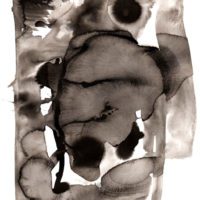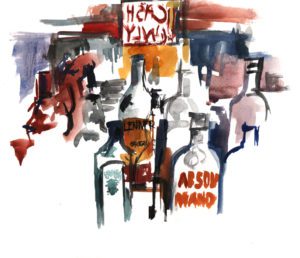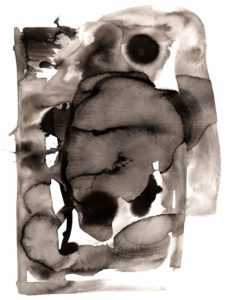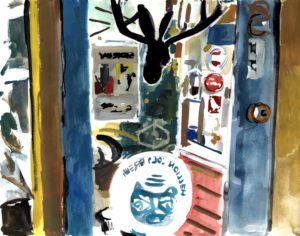This biological drive to seek balance, to chase pleasure and avoid pain, has helped us survive as a species for a very long time, but it is also a driving force in addictive tendencies. Addiction, simply put, is the extreme manifestation of the normal human condition.” —Curtis Buzanski
After approximately twenty-seven years of drinking toward the specific goal of acute intoxication, the drunk puts down the bottle. She puts down the tall aluminum can and the highball glass and the lowball glass and, in fact, all manner of glasses that are designed specifically for the containment of toxic fluids: pint, martini, coupe, snifter, flute, Collins, rocks, shot. The ex-drunk stops drinking and wonders why it was so important to have that many glasses in the first place, while the floors stayed sticky, and the car missed its tune-up for years, and the voice mails went unanswered, and the friendships withered, and the roof leaked until mold mushroomed in the closet corner.
Opening the cabinet, the ex-drunk now sees how priorities skewed—as clear as, well, glass: Drinking was the important thing, but also of significance was maintaining the illusion of sophistication around the drinking so that it all felt part of being adult and not like being driven by a drunk’s obsession.
Oh, I have just the glass for that particular poison, the drunk could say. Please overlook the everything else that’s in shambles.
***
In a flash of clarity that will never make rational sense (to her or to anybody else), the ex-drunk has her last drink on September 6, 2020. She is so physically ill from the final multiple-day spree that weeks pass before she has the stomach to finish the last of the benzodiazepines. Three neat servings swallowed three days in a row until they are gone on September 25: a relief to no longer think of them, to ask, Should I or shouldn’t I? every day. The ex-drunk had been drunk and high long enough to know it’s much easier to eliminate the question than to ask the question and expect the “right” answer. This same logic then propels the ex-drunk to quit cigarette smoking—the only capital-A addiction she has, really—on October 11.
All of this to say: In a span of five weeks, the ex-drunk now finds herself with nothing at all—nothing!—to fuzz the edges of life and so, like a poisoned rat leaving the home to seek water, she starts to scramble and clamber and shimmy and struggle, looking to replace her old deadly habits with all of the legal, or at least less deadly, highs in the world.
The ex-drunk, who could also be considered an ex-obese-child, turns first to her original drug, her pre-drug drug, which is food. Suddenly, her cavalier no-dessert philosophy has morphed into a near-constant quest for sugar, a phenomenon that she reads is a normal side effect for drunks who quit drinking. The freezer oozes with oat milk ice cream, dark chocolate bars stack on the top of the fridge, and the ex-drunk goes down the sweets aisle more times in one month than she has in three years.
In fact, she goes down all manner of heretofore ignored grocery store aisles, browsing the chips and the crackers and the granolas and the dried fruits and the chocolates and the cookies. “Think how many calories I’m not ingesting anymore,” the ex-drunk reasons. “I can eat whatever I want now!”
The ex-drunk feels a great freedom in this and makes, from scratch, fat-crust Detroit-style pizza twice in one week, stockpiles plant-based cookie dough, splits her lip on a jammed-in fistful of Spicy Sweet Chili Doritos. It’s a food free-for-all, for a time, but (like with alcohol) the junk emerges as just another empty promise: She always ends up feeling worse, not better, and indulging the urge leads only to the urge for more. At some point, the ex-drunk buys an e-book on how to halt “emotional eating.” Surely the problem is both physical and psychological, an attempt to fill unfillable holes. She never finishes the book. She both fantasizes about and fears complete freedom from substances. Surely it is too much to ask from a life, to lose every last comfort and crutch.
Ah, well!—without alcohol, a little weight still comes off, and finally, she gets sick of the unmitigated trash-food diet and trades her candies for brown rice and kale and liquid aminos. She is dismayed to find there’s another withdrawal in the aftermath, and her mood and energy careen for a few days. “Sugar is worse than cocaine,” the experts warn. Good thing she never got addicted to cocaine. But there was little danger in that; the ex-drunk has always considered herself a downer kind of girl.
Two months sober, the ex-drunk receives an offer from workmates: a free six-pack of no-alcohol beers. This frightens and intrigues her. Her friend, a drunk so advanced she must have kept him around partially to say to herself, I’m not that bad (also the principal function of the television show Intervention), doesn’t trust the prospect. He too is trying to quit drinking, because he is always trying to quit drinking, with varying degrees of success.
“Why would you even fuck with that!” he bellows. “I’ve bought nonalcoholic beer, and I’ll drink four in a row and go right out and buy the real thing.”
“Right,” the ex-drunk says on autopilot. She already knows she will accept the beer, ignoring the lazy lump of fear in her lungs.
Days later, she selects a snifter obtained at one of too many beer festivals in her drunken days. Keep the glassware! She always did. Glasses broke, like everything.
The fake craft beer is a delicate straw gold, foam topped. The ex-drunk knows it’s not the right beer for this particular type of glass. Craft beer was one of the ex-drunk’s most beloved obsessions, in her old life, and she reenacts the rituals: stuffing her nose past the rim, inhaling the scent of malt and hops. She sips. It tastes like beer.
Then, against logic, she starts to feel tipsy. I don’t need to drink real beer! the ex-drunk thinks triumphantly. I feel this!
Soon, she’s buying nonalcoholic beer every day, Googling “placebo effect.” By the end of the year, she decides to try her first Dry January by shunning nonalcoholic beer for the month. It is possible for the ex-drunk to overdo virtually everything.
After the one month off, she’s right back on it: now a daily fake-beer drinker. After a while, she isn’t sure if the placebo effect still works—if not, why does she want to drink this every day?—but either way, nothing matches the high she experienced the first time. Story of her life, eh? The ex-drunk needs to find something else to supplement the nonsensical comfort of fake beer. She never drank to get a slight buzz. She drank to annihilate herself.
Without alcohol, the ex-drunk seeks every normal-state alteration she can find, obsessed with being anything other than what she is at a given moment. Around the time she quits smoking, she begins a daily meditation practice. This is enough to get her subtly high for a few minutes here and there, including transcendent-type high at least twice, but after some months, the habit slips. She continues with daily walks, picking up autumn leaves along the way in a desperate attempt to find small thrills in nature. She does, but this too has limits.
So, the ex-drunk begins rigorous workouts—a four-week strength and conditioning challenge, online boxing and kickboxing classes, Pilates, Barre, Bollywood dance, HIIT, Tabata, boot camps. These seem the best solution, plus various ancillary benefits: floods of endorphins, full-body tingles, a burst of energy, better sleep. She begins daily yoga with lithe YouTubers and wonders where they get off even calling their videos “yoga,” which are more like glorified stretching in sequence and barely related to the ancient Indian practice—she has spent time in India studying with a swami and, like many drunks, assumes she knows everything. She follows along anyway: morning yoga, nighttime yoga, yoga for energy, yoga for sleep.
The ex-drunk had never been much of a shopper, since her “fun” money used to funnel into cigarettes and alcohol. Without these bottomless pits of purchasing, there is so much money. At first, she buys practical items: charcoal-gray bath rug, bed frame, academic planner, shiny new can opener. Then she justifies “sober treats”: luxury-label skincare, three new dogwood trees in the front yard, books that fall under the category known as “quit lit,” in which the protagonist, like the ex-drunk, puts down the drink. (Bonus: Books are another approved way to escape one’s present reality.)
With her senses now firing—without the deadening effects of alcohol and tobacco smoke—suddenly smell is a thing. She buys German aromatherapeutic bath salts, scented candles, fine fragrance, facial mists, fresh flower bouquets. She buys many houseplants. Not one survives, but they serve their purpose while living, breathing green against the smoke-yellowed walls. The ex-drunk sometimes regrets her purchases after buying, but at the time they often feel entirely justified, and only afterward entirely unsatisfying.
***
The ex-drunk could almost forget about the brief spate of sober shoplifting. Stealing was another long-ago, long-dead “habit” that raged in her preteen years and all but died in adulthood, except on exceedingly rare occasions when drunk. But without drinking, what’s the excuse now for “forgetting” to scan the second tube of $1.19 Blistex or the overpriced six-pack of Heineken 0.0 bottles?
The ex-drunk, now in weekly therapy for the first time, scans the depths of her psyche and wonders if stealing paltry items is a behavior designed to perform double-duty—not only for a cheap thrill but as an invitation to berate herself after she’s gotten away with it. Her inner critic is bored lately: Since she stopped drinking, there’s a dramatic dip in bad behavior, and breaking the law is a worthy transgression. Eventually, she gives up and pays for things—how embarrassing would it be to get caught stealing at forty years old?
One could say that the ex-drunk acquired a healthy addiction in the form of the whole “recovery” process in which she chooses to submerge herself, except everyone (including her) is soon sick of hearing about her latest epiphany, breakthrough, inkblot-bleeding location(s) on the emotion wheel, and/or “deep” psychological theory. In the first year of non-drunkenness, that stuff is near-constant—and plus, there are endless recovery people out there, ready to share their wisdom in online video chat rooms so you can steal the epiphanies of others when your own enlightenment lags.
The drunk attends meetings daily. They become her new binge, droning on loop in the background, especially on the weekends, which, without alcohol, usher in new oceans of open time. I must look like Mildred, she thinks—the screen-brainwashed wife from Fahrenheit 451—as meetings stream round the clock, sometimes for hours nonstop. Next, I’ll be calling them The Family.
They are, you see, like family now. She starts to know their names and cheers their progress from her side of the screen. They have no idea she exists, which comforts her. She wonders if one can do too much recovery. If so, she is doing it.
These virtual rooms are where the ex-drunk feels more at home now: in the land of gratitude and one day at a time and acceptance and self-care and making amends and all the inane platitudes that make sense now. Love yourself first. Let go and let God. This too shall pass.
Where else can she go? The ex-drunk’s old places are like graveyards, spooked and empty of allure. The bar glistens with suspicion; the casino shocks with sensory onslaught. Luckily, for the first few months—say, seven—the sheer novelty of sobriety (look, Ma, no hangovers!) creates its own high. But that wears off, too. Then another thing the recovery people say happens: Life gets life-y.
Despite her enthusiasm for fake alcoholic beverages, in most of her first year sober, the ex-drunk sticks to the 0.0% ABV beers, the ones that are truly alcohol-free, and avoids the brands that say in fine print: “Contains less than 0.5% alcohol.” She fears these on an irrational but instinctual level. In the AA meetings she observes online, they say, “Nonalcoholic beers are for nonalcoholics.”
Her nature walks spin more magic in springtime, but the ex-drunk’s quest for an ever-bigger high triggers a quintessential alky’s trick: the geographical cure. I need some fucking awe, she thinks, and lands on Maui. It’s August—her first birthday and vacation without drinking and smoking like a madwoman the whole way through.
In Hawaii, she buys a pricey kombucha and after paying sees the label: “Contains less than 0.5% alcohol.” She shrugs, opens, sips. She feels something, a little warm bloom in her belly, a half-second lightheaded interlude. Great, she thinks. Another thing to chase. The fear of the 0.5% is at once overcome and validated. Back home, she buys these beers to drink on an empty stomach, hoping that for a moment she will feel that same something small happen in her body, a minor sigh of relief.
But, if she is honest, the kombucha was not her first attempt at cheating. The 0.5% feeling reminds her of when she left apple juice too long in the fridge that spring and the plastic bottle extended and she poured a mocktail and there it was, there it had grown out of nowhere, she could smell it: alcohol. She felt, for a moment after sipping it, out of control and frightened. But then she settled into the feeling, and it went away and then she chased that, too. She tried to leave bottles of apple juice in the fridge too long, until they got foamy and fermented, until the bottle grew hard with trapped gases. A little juice could never count as alcohol. Still sober.
Other things that could not count as alcohol, consumed on a loop throughout that first year with great hope of altering the ex-drunk’s mood in some perceptible way: magnesium supplement powders and “adaptogenic” drinks with names like Dream Light and Calm and Nightcap and Zenify. (This ex-drunk finds no interest in staying awake, but in being relaxed to the point of zombie-like, if possible.) The drinks feature a slew of ingredients that do not achieve the high she’s seeking but sound healthy and exotic, like ashwagandha and L-theanine and lemon balm and tryptophan and rhodiola rosea extract and reishi mushroom and valerian root and white willow bark. She spends a lot of money on these newfangled drinks, but not as much as she spent on alcohol, which is a small but solid comfort.
In fact, the ex-drunk discovers she continues to have a drinking problem even without alcohol. She’s always sipping on something—seltzers in every findable flavor and mocktails and fresh-pressed juices and ice waters and many, many servings of coffee. She’s still somehow always thirsty. No doubt much of this compulsion is meant to replicate the action of drinking and smoking, to quench this hand-to-mouth disease. At least none of these drinks will kill her, even if the hunt for mood and mind-altering, for distraction, for something out there to help, may follow her to the grave.
No surprise that pills, a lifelong second love, re-enter the picture. The one upside of the mystery sting that blossomed into a thigh-wide rash—surely related to the gaggle of wasps that proliferated above her front door all summer—is that the doctor can be swayed with a simple sentence: “Do you have anything that can help with the discomfort?” The ex-drunk then tries to ration out the acetaminophen-codeine tablets. They are gone within the month, but this feels like a victory, as the ex-drunk could have easily swallowed them all in one week.
At some point, her days a patchwork whirlwind of mix-and-match replacement highs that still don’t quite do the job alcohol once performed, it just makes sense to reach for an old-reliable sort of solution, THC. The ex-drunk has miraculously never been addicted to this substance, and now there are entire states where it’s legal. Since she went through all of that trouble to quit smoking, she takes a hard stance on consuming edibles only (except that one or those two or three times when she says, Oh, who cares, I’ll just take a couple hits) and at one year sober, she’s at the recreational-use shop while vacationing in Boston, showing her ID as if outside a nightclub, buying THC- and CBD-laced lime seltzers and vegan candies. She then spends much of the trip in bed, unable to conjure up motivation for anything except ordering DoorDash dinners and, of course, returning to the shop for more edibles.
This phase lasts only a few months. These edible THC products never obliterate her in the way alcohol was able to, which is one reason she’s always felt safe from addiction to them.
Around this time, the ex-drunk falls in love with a man. She’s afraid that the chemicals flooding her are just another replacement, another blind search for another high—but no, the love appears genuine, and the high is as good as anything gets, maybe better. She doesn’t know how long it will last, but he lives far away and so the chemicals flood at every meeting after too many days apart. Her landline telephone lights up with his call every night and when that happens, she feels lit up, too. She hopes this relationship, like most relationships from her old drinking life—and like the drinking too, and like everything else—doesn’t become another bottomless pit of never enough of gimme of more.
Without the drink, you see, old ghosts visit often—the ghosts that one is accustomed to drinking to avoid, unresolved scars of the past. That November, for example: Emotionally marooned on family vacation, the ex-drunk is shocked back to an eye-rolling teen. Wasn’t her family one of the things she sought to escape in the first place? Desperate, she discovers local tiki-themed nonalcoholic bars that sell kava and kratom, leaves pulverized into powder and advertised to provide a certain euphoria. She’s never had either of these substances, so she tries both. Double-fisting as usual, she isn’t sure which is doing what, but the kratom seems to emulate an old favorite, opioids, which are harder to find since everyone realized how good they are—that is, until they are very, very bad. Why does everything work out that way?
She returns to the tiki bar four more times during the family vacation, then back at home orders two bags of kratom powder online. She stirs them into beverages every day: first one serving, then two, then four . . . she loses count. After a couple of months, she looks around: The combined consumption of edible THC and kratom has cranked to daily, sometimes round the clock. She’ll put down her nonalcoholic drink and forget where she left it, have trouble forming sentences, show up high for the sober book club and speak in circles. Finally, the intoxication, the euphoria, the oblivion she looked for all this time since quitting alcohol—she has found it.
Which means for sure she must give it all up. Suddenly, she feels back where she started, except the veil of denial can persist only weeks now, not decades. The ex-drunk has learned too much to use substances on autopilot, in ever-increasing quantities, remaining oblivious to her own well-worn patterns.
At least her inner critic feels glee: Why does she look for highs that she’ll inevitably overdo and must give up? How did she end up here again? Will her entire life always swirl around this endless chase? Will everything pleasurable always feel wrong, a slippery slope? Or is this cyclic abyss where the healing happens?
Is it not her fault at all? Is the want for more simply how human beings are wired?
The ex-drunk finds few concrete answers, but she knows she must quit the drugs. For now. Maybe this time I have learned something, she thinks, and the cycle starts again, but softer.
***
Rumpus original art by Dmitry Samarov
***
Voices on Addiction is a column devoted to true personal narratives of addiction, curated by Kelly Thompson, and authored by the spectrum of individuals affected by this illness. Through these essays, interviews, and book reviews we hope—in the words of Rebecca Solnit—to break the story by breaking the status quo of addiction: the shame, stigma, and hopelessness, and the lies and myths that surround it. Sisters, brothers, mothers, fathers, adult children, extended family members, spouses, friends, employers or employees, boyfriends, girlfriends, neighbors, victims of crimes, and those who’ve committed crimes as addicts, and the personnel who often serve them, nurses, doctors, social workers, therapists, prison guards, police officers, policy makers and, of course, addicts themselves: Voices on Addiction will feature your stories. Because the story of addiction impacts us all. It’s time we break it. Submit here.







